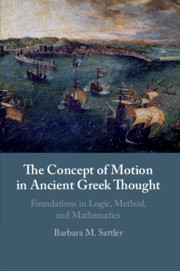Book contents
- The Concept of Motion in Ancient Greek Thought
- The Concept of Motion in Ancient Greek Thought
- Copyright page
- Contents
- Acknowledgements
- Introduction
- 1 Conceptual Foundations
- 2 Parmenides’ Account of the Object of Philosophy
- 3 Zeno’s Paradoxes of Motion and Plurality
- 4 The Atomistic Foundation for an Account of Motion
- 5 The Possibility of Natural Philosophy According to Plato I: The Logical Basis
- 6 The Possibility of Natural Philosophy According to Plato II: Mathematical Advances and Ultimate Problems
- 7 Aristotle’s Notion of Continuity: The Structure Underlying Motion
- 8 Time and Space: The Implicit Measure of Motion in Aristotle’s Physics
- 9 Time as the Simple Measure of Motion
- Bibliography
- Index Locorum
- General Index
8 - Time and Space: The Implicit Measure of Motion in Aristotle’s Physics
Published online by Cambridge University Press: 28 September 2020
- The Concept of Motion in Ancient Greek Thought
- The Concept of Motion in Ancient Greek Thought
- Copyright page
- Contents
- Acknowledgements
- Introduction
- 1 Conceptual Foundations
- 2 Parmenides’ Account of the Object of Philosophy
- 3 Zeno’s Paradoxes of Motion and Plurality
- 4 The Atomistic Foundation for an Account of Motion
- 5 The Possibility of Natural Philosophy According to Plato I: The Logical Basis
- 6 The Possibility of Natural Philosophy According to Plato II: Mathematical Advances and Ultimate Problems
- 7 Aristotle’s Notion of Continuity: The Structure Underlying Motion
- 8 Time and Space: The Implicit Measure of Motion in Aristotle’s Physics
- 9 Time as the Simple Measure of Motion
- Bibliography
- Index Locorum
- General Index
Summary
In Aristotle’s Physics we find for the first time motion and speed implicitly measured in terms of time and distance covered, as the discussion of book VI, chapter 2 shows. Aristotle’s explicit account of measurement, however, which he gives in Metaphysics Iota and with which this chapter starts, understands measure not only as homogeneous with the measurand, but also as one-dimensional only. Accordingly, the explicit measure of motion is simply time in the Physics, as we see from examining Aristotle’s understanding of time as the measure and the number of motion. For a full account of motion and speed and a complete response to Zeno’s challenge, however, a complex measure is needed, one that takes account of both time taken and distance covered. The chapter shows that this is exactly what Aristotle implicitly develops in his Physics, when he compares motions of different speed and responds to Zeno’s paradoxes of motion. But it is not what he can accommodate in his theory of measurement.
Keywords
- Type
- Chapter
- Information
- The Concept of Motion in Ancient Greek ThoughtFoundations in Logic, Method, and Mathematics, pp. 335 - 384Publisher: Cambridge University PressPrint publication year: 2020



